Photography Project at Home: Cyanotypes
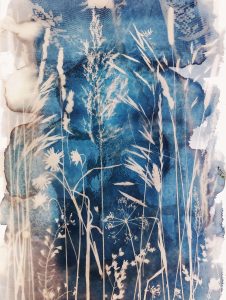
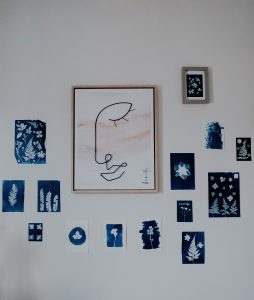
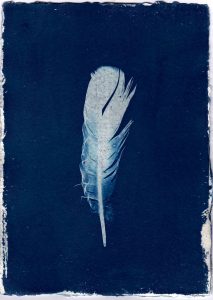
Welcome to our comprehensive guide on creating captivating and mesmerizing cyanotypes right in the comfort of your home. In this article, we will delve into the world of cyanotype photography, uncovering its history, techniques, and the step-by-step process to help you embark on your own creative journey. Whether you’re a seasoned photographer or just starting out, this guide will equip you with the knowledge and inspiration needed to create stunning cyanotype prints that will leave a lasting impression.
Unveiling the Allure of Cyanotypes
Cyanotype, a photographic printing process discovered by Sir John Herschel in the 19th century, is known for its unique blue hue and ethereal appearance. The process involves using two chemicals, ammonium iron(III) citrate and potassium ferricyanide, which react to UV light, resulting in a visually striking cyan-blue image. The beauty of cyanotypes lies not only in their distinct color but also in their simplicity and versatility.
Gathering Your Materials
- Before you embark on your cyanotype journey, gather the necessary materials:
- Cyanotype chemicals (Part A & Part B) e.g., from Jacquard. These usually come in a light-proof bottle in powder form and have to be diluted in water as per the instructions on the label. Once diluted, the salts have a shelf life of around a year. Keep parts A & B separate until you are about to coat the papers.
- Small container to mix the two parts, wide enough for the foam brush.
- Measuring spoons for mixing part A & part B in equal amounts.
- A set of foam brushes to evenly apply the solution.
- Heavyweight paper that can withstand being washed in water like watercolor paper.
- Backboard and glass from old picture frames or a contact printing frame to hold your compositions steady during exposure.
- Clips of varying sizes.
- Heavy-duty gloves.
- A long thin poker-like tool to nudge delicate plant material on the paper.
- An all-plastic spray bottle with a white vinegar solution – equal parts water and white vinegar should work fine, but feel free to experiment. Avoid a metal nozzle as the vinegar will eventually corrode it.
- Washing up liquid for the bubbles.
- A basin or tray to hold the soap bubbles, ideally large enough for your paper size.
- A large container to wash the exposed cyanotypes
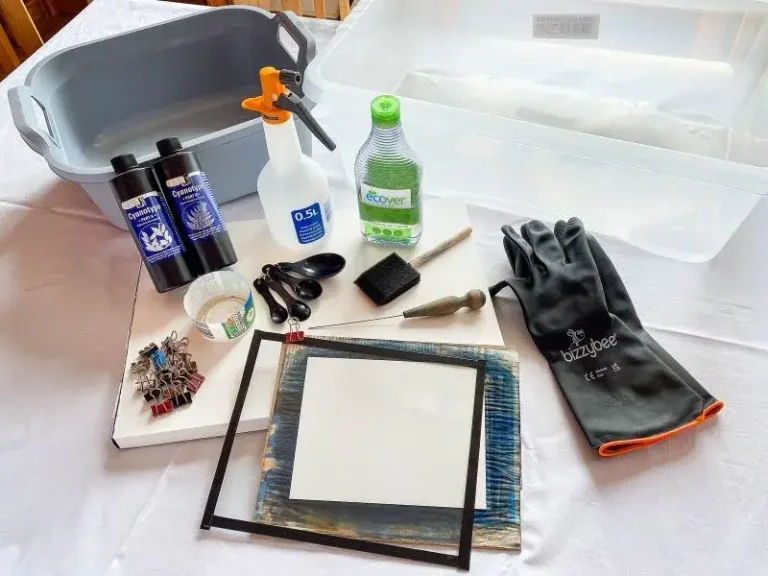
Mastering the Technique
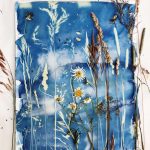
1. Coating the Paper
Start by coating the watercolor paper with a mixture of the cyanotype chemicals, creating a light-sensitive surface. Use a brush to evenly spread the solution, ensuring full coverage. Allow the paper to dry in a dark place, shielding it from any light exposure.
2. Arranging Your Composition
Place your chosen objects or negatives on the coated paper to create your composition. This is where your creativity truly shines, as you can experiment with different arrangements to achieve your desired outcome. Secure the objects in place using the contact printing frame.
3. Exposing to Light
Expose the composition to UV light – either sunlight or a UV lamp – for a specific duration. The length of exposure time will vary depending on the intensity of the light source and the look you’re aiming for. Keep in mind that longer exposure times result in darker shades of blue.
4. Development and Fixation
After exposure, rinse the paper in running water to remove any unreacted chemicals. Witness the magic unfold as the vibrant blue hues start to appear. Once the water runs clear, immerse the print in a mixture of water and hydrogen peroxide to fully develop the image. Rinse again, then fix the print with a water and citric acid solution to prevent fading.
Exploring Creativity and Beyond
Cyanotype offers a canvas for endless creativity. Experiment with various objects, negatives, and even techniques like double exposures to create captivating and unique prints. The process encourages a hands-on approach, allowing you to infuse your personal touch into every piece.
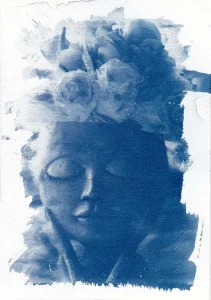
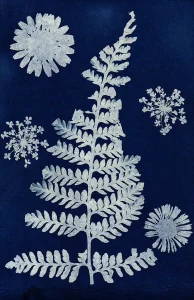
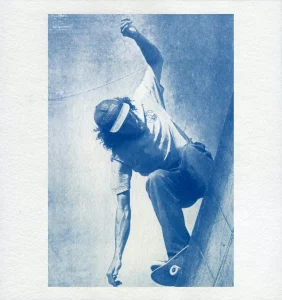
Preserving Your Masterpieces
To ensure your cyanotype prints withstand the test of time, frame them behind UV-protective glass. This not only showcases your work but also safeguards it from fading due to prolonged sun exposure.
Embarking on a photography project at home, specifically cyanotypes, opens up a world of creativity and self-expression. The allure of the cyan-blue tones, the historical significance, and the hands-on process make it an art form worth exploring. Whether you’re an experienced photographer or a beginner, the journey of creating cyanotypes is a rewarding one that unveils the hidden artist within.
